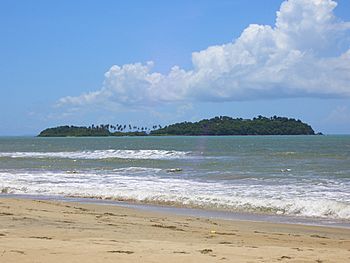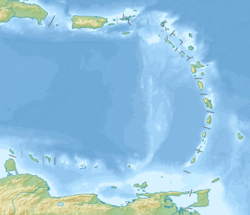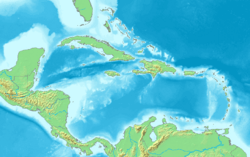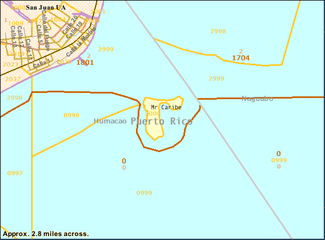Cayo Santiago facts for kids
 |
|
| Geography | |
|---|---|
| Location | Humacao, Puerto Rico |
| Coordinates | 18°9′23″N 65°44′3″W / 18.15639°N 65.73417°W |
| Area | 0.139179 km2 (0.053737 sq mi) |
| Length | 0.6 km (0.37 mi) |
| Width | 0.4 km (0.25 mi) |
| Highest elevation | 34.9 m (114.5 ft) |
| Highest point | El Morrillo or "Big Cay hill top" |
| Administration | |
| Commonwealth | Puerto Rico |
| Municipality | Humacao |
Cayo Santiago, also known as Santiago Island, Isla de los monos (or Island of the monkeys), is located at 18°09′23″N 65°44′03″W / 18.15639°N 65.73417°W, 0.59 mi (0.95 km) 0.6 mi (1.0 km) to the east of Punta Santiago, Humacao, Puerto Rico.
Geography
The island measures approximately 37.5 acres (15.2 ha), 660 yards (600 m) north–south and 440 yards (400 m) east–west, including a "Small Cay" which is connected to the main part ("Big Cay") by a narrow sandy isthmus. Six hundred meters west of the southernmost point is a shoal, Bajo Evelyn, which has a shallow depth of 8 fathoms. While the island is flat in the north, it reaches a height of 114.5 ft (34.9 m), 1.8 mi (2.9 km) southwest of the island's port, on a small rocky hill called El Morrillo, which rises abruptly from the water and the lowland around it. The area of the island is 0.054 sq mi (0.14 km2): Block 2000, Census Block Group 2, Census tract 1801, Humacao Municipio, Puerto Rico), of which the northeastern peninsula accounts for about 0.01 sq mi (0.03 km2).
In the late 1940s, the island was expropriated by Puerto Rico from its private owners and ceded to the University of Puerto Rico. Only researchers are allowed on the island, but tourists can charter a boat to view the island and its primate inhabitants.
Fauna
Since December 1938, the island has been the habitat for a free-ranging population of Rhesus monkeys. The monkeys are the offspring of an original group of 30 monkeys imported from India by Clarence R. Carpenter and the School of Tropical Medicine in San Juan that was operated by Columbia University College of Physicians and Surgeons and the University of Puerto Rico. Today, the colony, which numbers over a thousand animals, serves as a research resource supported by the National Institutes of Health and the University of Puerto Rico Caribbean Primate Research Center for investigators from many institutions in the US and several in Europe. A pictorial history on the 75 years of the colony was recently published [see external link].
Cayo Batata, a small island located 4 mi (6 km) to the southwest of Cayo Santiago, is under the jurisdiction of Humacao and is uninhabited by humans.
Gallery
See also
 In Spanish: Cayo Santiago para niños
In Spanish: Cayo Santiago para niños








